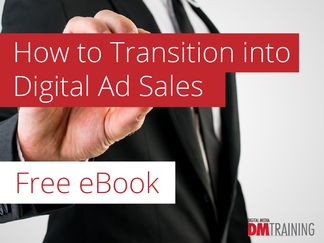Gaining A Competitive Advantage - How to Position Your Digital Sales
If you are selling advertising today, you’re always competing whether you realize it or not. You’re up against competitors that you know about, as well as those you don’t.
Assume 10-30 competitors per day are reaching out to your customers and prospects trying to win them over.
To the advertiser, you may all seem alike. Every one of you essentially “argues” the same thing - “We’ll get your message in front of the right people, at the right time, with the right ROI”.
To gain a competitive advantage in the market today, it’s more important than ever for you to make your argument compelling and more persuasive by pointing out your unique differences. Do it right and you’ll get the customer’s attention and their budget.
If you’re selling relatively low-cost inventory, you may claim that your low point of entry or low CPM will undoubtedly have a positive ROI. If you offer premium inventory, you will argue that your premium CPM inventory has the best cost per engagement (CPE), meaning that the value of the conversions off-sets the media cost.
But what else can you talk about apart from the cost of your media?
Try focusing on the value of your inventory from a performance point of view, as well as, your technology, your process, and your people.
In a competitive situation, the most essential part of articulating your unique differences is producing the right response. If you want a better response to your pitch, consider these 4 sales principles:
 1. Numbers
1. Numbers
You should know how many things make you different and start your explanation with that number.
Your goal, as a salesperson, is to convince your prospects that there are only two kinds of companies out there: all the other companies, who all do basically the same thing and then there’s your company, the only one out there that is doing something truly unique.
“There are 4 (or 3 or 5) things that make us different…” is a confident way to begin and it helps the listener organize your pitch in their head. They’ll now be listening for the 4 (or 3 or 5) items, instead of just thinking the only difference is the media cost.
2. By-Degree
Some things are the same even if you’re doing them slightly differently.
For example, every campaign, particularly digital campaigns, include optimizing. But, optimizing isn’t simply on or off. If everyone optimizes, but you use both auto-optimizers and human optimizers, that is a great by-degree difference.
Maybe everyone uses auto and human optimizers, but most of your competitors never really look at a campaign or only look once a month. Meanwhile your company optimizes every day. Then that’s your by-degree difference.
Maybe they also optimize using auto and human optimizers every day, but your technology is faster and your data is better. Never forget about the human resources: maybe your team working on optimizing local campaigns is more experienced than anyone else. In that case, it is the combination of optimization, data, and experience which form your by-degree difference.
3. Prioritize
Any numbers you are citing should be prioritized so that they reach a crescendo. Simply reciting a bunch of big and small numbers, percentages and whole numbers, tends to confuse most listeners. They’ll tune out before trying to make sense of it all.
They won’t be able to remember any of it and most importantly won’t be able to later relay those numbers on to other decision makers.
Instead of confusing them, give them an easy way to repeat your sound bite, by staging the data in a particular order. For example, “We reach 1 million uniques, 10 million visitors, and serve them more than 1 billion targeted impressions.”
This makes it easier for you to ensure the numbers have true impact and you’ll be better able to control the communication to other influencers in the buying process.
4. Your angle
Tell them which side you’re on!
Umbrella or specialist? Proprietary vs. best in breed? What verticals does your team specialize in? Or is your value in the fact that you’re the only company with in-depth knowledge across the entire spectrum of industries and advertiser goals? Is your technology better because it is the best-in-class, most respected, or because it is proprietary?
Either way, you’re certainly unique, especially when combined with other advantages - make sure you spell this out.
Every salesperson is trying to gain a competitive edge. Focusing on the right things, especially when describing your unique advantages during important meetings can make all the difference.
About Steve Bookbinder
Steve Bookbinder is the CEO and sales expert at DMTraining. He has delivered more than 5,000 workshops and speeches to clients all over the world and has trained, coached, and managed more than 50,000 salespeople and managers. Steve continuously refreshes his training content to reflect his latest first-hand observations of salespeople across industries and regions. Through him, participants in his workshops and coaching sessions learn the best practices of today’s most successful sellers and managers across industries. Steve understands that sales is a competitive game. To outperform competitors and our own personal best results, we need to out-prospect, out-qualify, out-present and out-negotiate everyone else, not merely know how to sell. Through his specialty programs in Pipeline Management, Personal Marketing, Great First Meetings, 2nd-level Questioning, Sales Negotiating, and Sales Coaching, Steve trains sales teams to master the skills they need to overcome the challenges they face in today’s world… and keep improving results year over year.





